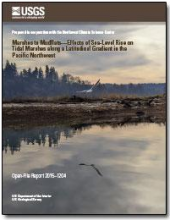Marshes to mudflats—Effects of sea-level rise on tidal marshes along a latitudinal gradient in the Pacific Northwest

In the Pacific Northwest, coastal wetlands support a wealth of ecosystem services including habitat provision for wildlife and fisheries and flood protection. The tidal marshes, mudflats, and shallow bays of coastal estuaries link marine, freshwater, and terrestrial habitats, and provide economic and recreational benefits to local communities. Climate change effects such as sea-level rise are altering these habitats, but we know little about how these areas will change over the next 50–100 years. Our study examined the effects of sea-level rise on nine tidal marshes in Washington and Oregon between 2012 and 2015, with the goal of providing scientific data to support future coastal planning and conservation. We compiled physical and biological data, including coastal topography, tidal inundation, vegetation structure, as well as recent and historical sediment accretion rates, to assess and model how sea-level rise may alter these ecosystems in the future. Multiple factors, including initial elevation, marsh productivity, sediment availability, and rates of sea-level rise, affected marsh persistence. Under a low sea-level rise scenario, all marshes remained vegetated with little change in the present configuration of communities of marsh plants or gradually increased proportions of middle-, high-, or transition-elevation zones of marsh vegetation. However, at most sites, mid sea-level rise projections led to loss of habitat of middle and high marshes and a gain of low marshes. Under a high sea-level rise scenario, marshes at most sites eventually converted to intertidal mudflats. Two sites (Grays Harbor and Willapa) seemed to have the most resilience to a high rate of rise in sea-level, persisting as low marsh until at least 2110. Our main model finding is that most tidal marsh study sites are resilient to sea-level rise over the next 50–70 years, but that sea-level rise will eventually outpace marsh accretion and drown most habitats of high and middle marshes by 2110.
Thorne, K. M., B. D. Dugger, K. J. Buffington, C. M. Freeman, C. N. Janousek, K. W. Powelson, G. R. Gutenspergen, and J. Y. Takekawa. 2015. Marshes to mudflats—Effects of sea-level rise on tidal marshes along a latitudinal gradient in the Pacific Northwest. USGS Numbered Series, U.S. Geological Survey, Reston, VA. http://dx.doi.org/10.3133/ofr20151204.
